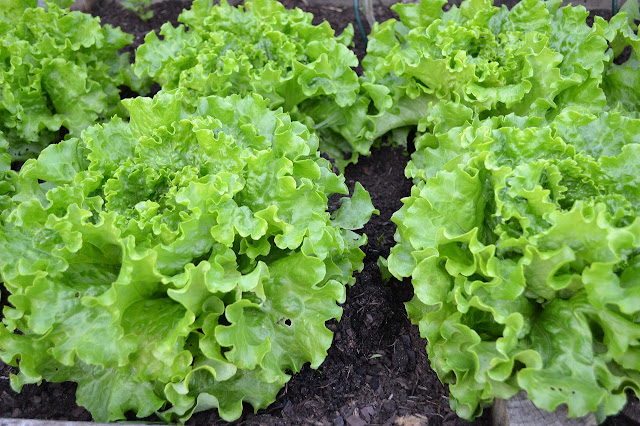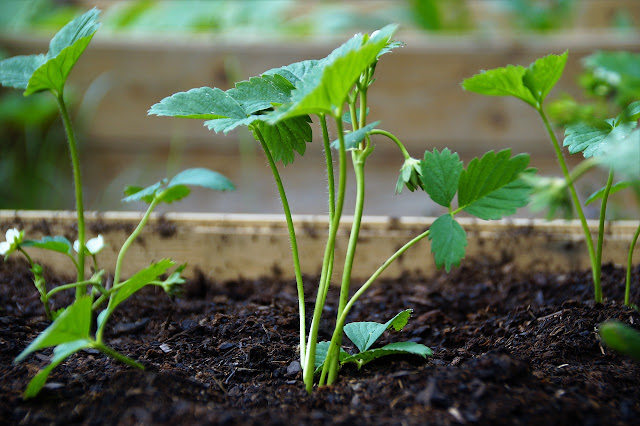Lettuce is a simple vegetable to grow. Growing your own lettuce is significantly less expensive than buying bags of lettuce from the store, and you can produce a wider range of lettuces than you can with store-bought lettuce. Lettuces are available in many different forms, colors, and textures. You'll have all the components for a wonderful, colorful salad if you plant a few types.
Lettuce Varieties
You may grow a variety of lettuce varieties. Leaf lettuce is one of my favorites since it grows rapidly and you can pick for weeks from one plant, but there are many types available in seed catalogs and on seed racks:
Looseleaf - Looseleaf lettuce is one of the most simple to grow. It's also quite fast, taking only five or six weeks to create huge loose heads.
Oakleaf - I plant oakleaf lettuces as leaf lettuces and pick them frequently as the plants mature. If they are allowed to mature, they will ultimately grow into full-size heads. The leaves are lobed like oak leaves, and depending on the cultivar, they might be green or red.
Romaine - lettuce plants produce tight, erect heads of crisp leaves, which are used in Caesar salad.
Butterhead - Also known as Boston or Bibb lettuce, butterhead lettuce produces wonderful loose heads of soft crisp leaves. Butterhead types that are heat tolerant may be produced in the summer, as well as cold tolerant variants that can be harvested in the winter.
Iceberg - Iceberg lettuce, also known as crisphead lettuce, has a bad reputation, but I've had no trouble growing it in my raised beds.
Summer Crisp - At first glance, summer crisp lettuces, also known as Batavia lettuces, resemble looseleaf kinds. However, as they grow older, they have lovely rounder heads. There are numerous heat-tolerant types that are ideal for growing in the summer.
Plantings in succession
Lettuce is an excellent choice for succession planting. Starting with early lettuce types, choose heat-tolerant kinds as your main crop, and then transition to fall crops late in the summer, sow seeds every two weeks for output throughout the season. Use lettuce in succession with other crops if you wish. Plant lettuce in the spring, bush beans in the summer, and lettuce once more in the fall, for example.
Watering
The key to lettuce production, especially in hot conditions, is to provide moderate but practically continuous water. If there isn't enough rain, lettuce has to be watered deeply at least once a week, and more frequently during droughts. To assist the soil retain moisture, mulch with a layer of compost or clean straw. It's best to use a drip watering system.
Growing Lettuce Tips
Consider using the four ways below to boost total lettuce production.
Raised beds
Plant lettuce seeds on raised beds to increase yield. The elevated beds heat considerably more quickly than the ground around them. In the spring, you should be able to get a head start, and in the fall, you should be able to harvest later.
Living Mulch
Plant lettuce among taller plants like broccoli, Brussels sprouts, peppers, and eggplants to make the most of limited garden space. The lettuce aids its neighbor by keeping the soil moist and cold, as well as shading away weeds. As the plants grow higher, they offer much-needed shade for the lettuce as the days become hotter.
Tucking
You can also plant lettuce seedlings inside in late spring and early fall to fill in gaps in the garden when other crops are harvested. To maintain every inch of garden area in continual production, just 'tuck' a seedling in the empty location.
Use as a decoration
Lettuce comes in a variety of colors and shapes, and it's a great accent to any flower bed. 'Mighty Red Oak,' 'Sweet Red,' and 'Sierra Blush,' for example, may be used to fill in gaps in flowerbeds and provide splashes of red where needed.
Harvesting Lettuce Tips
After actual leaves have formed, lettuce can be picked at any time. Pick lettuce early rather than late for the finest quality, since lettuce that has been left to grow too long will become bitter and tough.
If you want to harvest entire heads of crisphead, Batavia, and romaine kinds, clip the plant just at the soil line when it's ripe. With butterhead and looseleaf lettuce, you may do the same thing, but I prefer to take only the outer leaves as needed. This allows the plants to continue to produce for a longer period of time. Harvest the leaves early in the morning when they are crisp, delicious, and juicy.
When a lettuce plant's crown elongates, it's going to bolt and generate seed, signaling that the plant is past its prime. Remove the lettuce plant, dump it in the compost, and replace it with another crop, such as bush beans or a lettuce seedling.
Recipes for Lettuce and How to Store It
Lettuce, which is mostly water, does not keep well. Use homegrown lettuce as soon as possible after harvesting for the highest quality and flavor. This is especially true for many looseleaf cultivars that wilt quickly.
Combine crunchy, crisp lettuces with soft, buttery-smooth lettuces. For example, a tossed salad with a variety of colors, shapes, and textures may be made by combining 'Little Caesar,' 'Burpee Bibb,' 'Mighty Red Oak Leaf,' and 'Crispy Frills.' Try a few different mixes until you discover one that suits your taste buds the best.
Diseases of Lettuce
Downy Mildew
Downy mildew is a fungus that, once established, may infect up to 80% of an area. This disease frequently affects mature leaves. The upper side of lettuce leaves produces a yellow region, while the bottom develops a white or gray fluff.
Leaf Spot
Weeds cause this illness, which normally affects less than 5% of farmland. Leaf spot is a typical fall ailment due to the warm temperatures.
Lettuce Mosaic Virus
Lettuce mosaic virus-affected wrapper leaves are dull, bent backward, and have increased marginal serration. In addition to leaf blistering, Romaine lettuce leaves usually exhibit the same symptoms. Stunting and severe chlorosis affect butterhead lettuce.
Tomato Spotted Wilt Virus
This virus, which is spread by thrips, was originally discovered in 2004 and is expected to grow in the future years.
Bottom Rot
Bottom rot is a disease that affects iceberg, Boston, and Bibb lettuce cultivars and is most noticeable in warm weather. Although this illness normally causes less than 5% of land to be lost, it can damage up to 100% of acreage in exceptional situations. Bottom-rotting lettuce normally loses a few of wrapper leaves.
Drop
Drop impacts one to two percent of area each year, although it is usually only a problem when the land is unable to be flooded in the summer. The disease targets older leaves first, causing them to wilt, and then the sickness spreads to younger and outer leaves, causing the plant to collapse.
Bacterial Infections
Bacterial corky root rot, bacterial soft rot, and a variety of other illnesses that can harm roots, leaves, and potentially the entire plant are among them.



.png)







Comments
Post a Comment